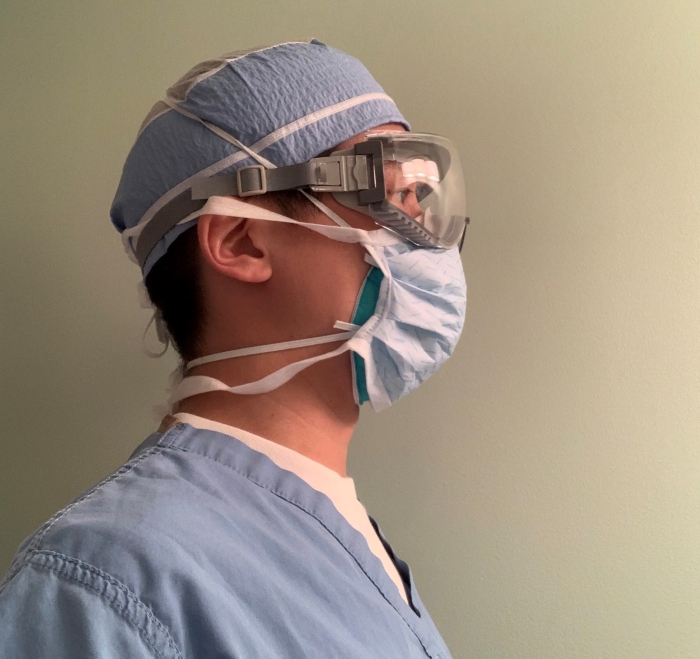“None of us lives to himself.” – Romans 14:7
My brother John* is the youngest of us three kids, and the only boy. Since I am the firstborn, and nine years older than him, I was not just a big sister but almost a second mother to him when we were growing up, as our dad worked overseas for a number of years and our mom worked two jobs as a registered nurse. I helped feed and bathe John when he was a baby and drove him to soccer practice and birthday parties when he was a kid.
Once, when he was 9 or 10, working on a school science project at home, he split open a rock and was hit in the eye by a stray rock chip. It was the 1980s, and kids weren’t generally equipped with safety equipment
like goggles or helmets back then. His eye instantly filled with blood, which was the scariest thing I’d ever seen. I was still a teenager, and I remember trying to stay calm as I called our mom, then drove John to the emergency room, silently praying that his eye wasn’t permanently damaged. Thankfully, his eye healed.
My baby brother is not a baby anymore. He’s an adult, a husband and the father of two young children. He is also a doctor practicing in New York City, the epicenter of the U.S. coronavirus crisis. As an anesthesiologist at an orthopedic hospital, he does not usually treat sick people. But in response to the pandemic, his hospital canceled all elective surgeries and converted 16 operating rooms into an intensive care unit to handle the overflow of non-COVID-19 patients displaced by the surge of infections. Last week, in response to the rising flood of cases in New York, his hospital began accepting COVID patients, too.
After his residency, John completed a fellowship in critical care, so his training is putting him on the frontline of this war against an invisible enemy. At the time of writing, he is now in the midst of his third full week of 12-hour shifts in the ICU. Midway through his first week, he experienced his first COVID patient death. While he thankfully feels fine physically, emotionally he says he is “about done.”
John is staying in an apartment in the city during his shifts, so he can quarantine himself away from his wife and kids. Before that, he self-isolated within his house, staying in the basement and FaceTiming with his family upstairs. He, like so many other frontline health care workers, is trying to protect his family from potential exposure. But in doing so, he is isolated at a time when he most needs support.
It’s hard to be so far away from John while he’s in crisis mode. My parents, sister and I all live in Southern California. Alarmed by news reports that New York hospitals don’t have enough personal protective equipment, our mom sourced masks, drove to L.A. from Orange County to pick them up and shipped them to him. But they weren’t medical-grade N95, so they are useless for his work.
We are worried that John won’t eat, especially if he is on his own, exhausted and stressed beyond limits. We want him to keep up his strength and bolster his immune system. As our grandma often told us, “food is medicine.” Food is also love. Our sister sent him potato balls, chicken empanadas and guava strudel from Porto’s Bakery to tempt his appetite. I baked him banana bread with extra chocolate chips.
I ask my brother how else we can help. He says to “just take care of Mom and Dad,” so he doesn’t have to worry about them. Our dad is 79 and has chronic health issues that make him high-risk. John says if Dad were to get COVID-19, the risk of mortality would likely be between 25 and 40 percent. It is a sobering thought. Mom has taken leave from her hospital to reduce the chance of exposure and to care for Dad full-time, now that the senior center he went to daily is closed. This creates its own set of pressures, but for now home is the safest place for them to be.
I don’t take care of my brother anymore, the way I did when we were growing up. He is independent and self-sufficient, more than capable of taking care of himself, his family and his patients. But this public health crisis is showing us how interconnected we all are, how what we do affects those around us in both big and small ways. Going out in public can mean risking exposure to infection and transmitting the virus before we even know we have it. Hoarding products like toilet paper and disinfectants leads to empty shelves for everyone else. While the two may not seem related, both involve measuring out resources so that they will be available for all of us when we need them, whether the resources are as critical as respirators or as mundane as toilet paper. By staying home and staying well, we can reduce the rate of infection and avoid overwhelming our health care system. We can protect one another and help each other stay healthy amidst this pandemic.
The stay-at-home orders come at a steep cost to our finances, that is undeniable. The government must balance the interest of public health against the interest of our economy, and as the costs mount, that calculus becomes more complicated. This is a shared challenge, and it takes a shared response to meet it.
What we are buying with our sacrifice is precious time. Time for health care workers to mete out limited resources of staff and equipment. Time for scientists to develop tests, vaccines and a cure. Time for us to remain well.
We have all seen the tributes to health care workers in the news. I recently read a post on NextDoor calling for people to drive to their local hospitals every evening to honk and cheer for the hospital workers. These tributes are well-intentioned, and certainly well-deserved. But what health care workers, like all of us, really need is not accolades, but protection. Just as my brother needed goggles when he was doing his school science project, he needs protection to do his job now. We can offer a shared shield of protection just by staying home, and by wearing masks during the infrequent times we go out.
Stay home. Stay well. We are each our brothers’ (and sisters’) keepers.
*Not real name, alias used to protect privacy.
This article appeared in “Character Media”’s April/May 2020 issue. Check out our current e-magazine here.









